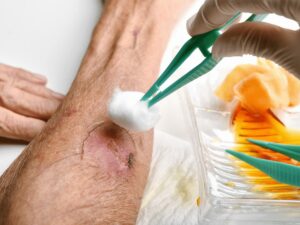Could a hyperbaric machine for diabetes be the breakthrough we’ve been waiting for? Recent findings suggest yes, offering new hope to those managing this challenging condition.
With years of expertise in hyperbaric therapy and a focus on innovative treatments, my insights offer valuable perspectives on this evolving field.
Hyperbaric oxygen therapy presents an intriguing option for diabetes management, potentially improving wound healing and reducing complications.
In this guide, we’ll explore how hyperbaric oxygen therapy benefits diabetes patients, including its mechanisms, research findings, and practical applications.
Read on to uncover how to transform diabetes care!
Hyperbaric chambers are revolutionizing medical treatment by providing 100% oxygen at elevated pressures, far beyond what is possible in normal atmospheric conditions. This method significantly enhances the body’s oxygen absorption, offering breakthroughs in treating various health issues—from severe infections and stroke recovery to persistent wound healing.
Reflecting its expanding role in healthcare, the hyperbaric chamber market is set to grow by 8% from 2022 to 2029, as reported by Globe News Wire. This growth underscores the therapy’s evolving application and its emerging significance in advancing medical treatments beyond traditional boundaries.
Following our overview of hyperbaric chambers and their broad applications in modern medicine, it’s clear that they holds significant potential beyond just treating decompression sickness and wound care. Here are some key points:
Following our exploration of the connection between hyperbaric oxygen therapy and diabetes, it’s clear that hyperbaric chamber offers a compelling approach to managing some of the complications associated with diabetes. Here are the key benefits that hyperbaric chambers bring to diabetic patients:
Diabetic patients often struggle with wounds, particularly foot ulcers, that heal slowly and can lead to severe complications. Hyberbaric chambers enhance the healing process by increasing the amount of oxygen in the blood, which in turn speeds up tissue repair and regeneration. It’s a breakthrough for many, turning what can be a long and anxious waiting game into a faster journey to recovery.

One of the most feared complications of diabetes is the need for amputation, typically due to non-healing ulcers and severe infections. Hyperbaric chambers can significantly lower this risk by promoting wound healing and fighting infection. For diabetic patients facing the possibility of amputation, HBOT offers a ray of hope, providing a viable option to save their limbs and enhance their quality of life.
Infections are a common and serious complication in diabetic wounds, often exacerbating the difficulty of managing diabetes. For instance, the increased oxygen levels provided by a hyperbaric chamber create an environment less conducive to bacteria that thrive in low-oxygen conditions. This helps to control and prevent infections, making it easier for wounds to heal and for patients to recover more quickly.
Beyond the physical benefits, hyperbaric chambers can significantly improve the quality of life for diabetics. By reducing the risk of amputations, accelerating wound healing, and controlling infections, patients can enjoy a more active, less hospital-bound lifestyle. OxygenArk recognizes that this improvement in overall well-being is perhaps one of the most meaningful benefits, allowing patients to lead fuller, more independent lives.
After diving into the benefits of hyperbaric chambers for diabetic patients, you might be wondering, “What does the treatment process look like?” Let’s walk through the steps involved in HBOT:
The first step is an initial consultation and medical evaluation. This is when a healthcare provider looks into the medical history and current health to see if HBOT is right for an individual. They’ll ensure that HBOT is a safe option, tailoring the treatment to the specific needs. Think of it as mapping out the journey to recovery, with each patient getting a personalized roadmap.
Next comes preparation. Patients will get the rundown on what to wear (think comfy, cotton clothes) and what the session will entail, including how to pop the ears to deal with pressure changes. It’s all about making sure they are as comfortable as possible before stepping into the chamber. This part is crucial because, let’s face it, the better the patient feels going in, the more relaxed they’ll be during the treatment.
Whether in a solo or with others, the chamber is sealed, and the pressurization begins. The patient will breathe normally, soaking in pure oxygen, and each breath brings more oxygen into the bloodstream than a person would ever get at sea level. Sessions usually last about 90 to 120 minutes, a perfect slice of time for some quiet reflection or simply to relax. It’s a unique experience, kind of like a peaceful, healing mini-retreat.
Here’s a table about what to expect during a hyperbaric oxygen therapy (HBOT) treatment session:
| Step | Description | Notes |
| Chamber Sealing | The hyperbaric chamber is sealed to begin pressurization. | Can be a solo or group setting, depending on the type of chamber. |
| Pressurization | The chamber’s pressure gradually increases, simulating a dive below sea level. | The process is controlled and monitored by healthcare professionals. |
| Oxygen Breathing | Patients breathe in 100% oxygen, significantly more than the 21% found in normal air at sea level. | Breathing normally, each inhalation saturates the bloodstream with oxygen. |
| Duration | Treatment sessions typically last 90 to 120 minutes. | Time can vary based on the condition being treated and the specific protocol being followed. |
| Experience | The session offers a chance for relaxation or quiet reflection. | Many patients describe the experience as peaceful and rejuvenating. |
After the session, the pressure is gradually normalized, and the person might feel a bit tired or light-headed, but this fades quickly. The follow-up care is about seeing how well the treatment is working and making any needed adjustments. OxygenArk suggests that regular check-ins help track your progress, ensuring the therapy is hitting the right notes in your recovery process.
After going through the hyperbaric chamber treatment process, it’s clear that while the therapy is packed with benefits, understanding its potential risks and side effects is equally crucial. Here are the main points to keep in mind:
After understanding the potential risks and side effects of hyperbaric chambers, it’s fascinating to compare them with traditional diabetes treatments. Here is how these 2 approaches stack up:
Traditional diabetes treatments often focus on controlling blood sugar to prevent complications, including wound issues. However, hyperbaric chambers directly address wound healing by increasing oxygen levels in the blood, which speeds up the repair process. It’s like giving a turbo boost to the body’s natural healing ability, making it a valuable addition, especially for stubborn diabetic foot ulcers.

Diabetes can lead to complications like neuropathy and vascular disease, typically managed with medications, lifestyle changes, and sometimes surgery. Hyperbaric chambers offer a different approach by enhancing oxygen delivery to affected tissues, potentially reducing the need for invasive treatments. It’s not just treating symptoms but actively promoting the body’s ability to heal itself.

While traditional treatments are essential for managing blood sugar levels and preventing complications, hyperbaric chambers add another layer of care. Incorporating HBOT into a diabetes management plan could mean fewer hospital visits and a better quality of life. It’s an innovative approach that complements traditional care, offering hope where standard treatments might fall short.

After comparing hyperbaric chambers to traditional diabetes treatments, it’s clear that they offer unique benefits for wound healing and complication management. But if you’re a diabetic person considering HBOT, there are practical considerations to keep in mind. Here are the key aspects:
First, it’s crucial to consult with your healthcare provider to evaluate if using hyperbaric chambers is suitable for your specific condition. Not all diabetic complications may be appropriate for HBOT, and it’s important to ensure that your overall health and specific medical conditions are taken into account. This step guarantees that you’re making an informed decision based on your health needs.
The cost of using hyperbaric chambers can vary, and it’s essential to understand the financial implications before starting treatment. Check with your insurance provider about coverage options, as not all plans may cover HBOT for diabetes-related conditions. Being aware of potential out-of-pocket costs upfront can help you plan and avoid surprises down the line.
Preparing for a hyperbaric chamber involves understanding what the treatment sessions entail, including their duration and frequency. For instance, familiarize yourself with the process, from how to dress for sessions to what you can do during treatment. Being prepared can help make the experience as comfortable and stress-free as possible.
Think about the logistics of undergoing hyperbaric chamber therapy, such as travel to the treatment facility, scheduling sessions around your daily life, and the commitment required for the full course of treatment. It’s important to consider how HBOT fits into your lifestyle and whether adjustments are needed to accommodate your treatment schedule.
As we’ve navigated through the intricacies of hyperbaric chambers for diabetes, it’s clear that they offer more than a glimmer of hope for those grappling with the condition. The therapy helps the body’s tissues stimulate healing, reduces inflammation, and enhances the body’s natural ability to fight infection and heal wounds.
If you are looking for a reliable hyperbaric chamber manufacturer, OxygenArk is committed to delivering quality and reliability. Contact us today to learn how we can benefit your facility or practice.
Get in touch with us and unlock your full well-being potential!
The OxygenArk team is here to assist you every step of the way.